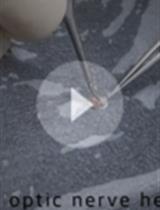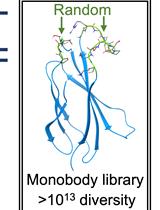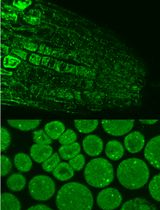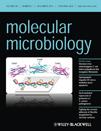- Submit a Protocol
- Receive Our Alerts
- Log in
- /
- Sign up
- My Bio Page
- Edit My Profile
- Change Password
- Log Out
- EN
- EN - English
- CN - 中文
- Protocols
- Articles and Issues
- For Authors
- About
- Become a Reviewer
- EN - English
- CN - 中文
- Home
- Protocols
- Articles and Issues
- For Authors
- About
- Become a Reviewer
Immunoblot Analysis of Histone H4 Acetylation and Histone H2A Phosphorylation in Candida albicans
Published: Vol 3, Iss 20, Oct 20, 2013 DOI: 10.21769/BioProtoc.943 Views: 9568
Reviewed by: Fanglian He

Protocol Collections
Comprehensive collections of detailed, peer-reviewed protocols focusing on specific topics
Related protocols

Non-separate Mouse Sclerochoroid/RPE/Retina Staining and Whole Mount for the Integral Observation of Subretinal Layer
Sung-Jin Lee and Soo-Young Kim
Jan 5, 2021 4038 Views

Construction of a Highly Diverse mRNA Library for in vitro Selection of Monobodies
Taishi Kondo [...] Hiroshi Murakami
Aug 20, 2021 3578 Views

Immunofluorescence for Detection of TOR Kinase Activity In Situ in Photosynthetic Organisms
Ana P. Lando [...] Giselle M. A. Martínez-Noël
Dec 20, 2024 1473 Views
Abstract
Posttranslational modifications of histones are required for different processes including transcription, replication and DNA damage repair. This protocol describes the preparation of a whole-cell extracts for the fungal pathogen Candida albicans. Furthermore, the extract is used to detect lysine acetylation of histone H4 as well as serine 129 phosphorylation of histone H2A by immunoblot analysis.
Materials and Reagents
- Candida albicans
- TCA (trichloroacetic acid) (Merck KGaA, catalog number: 641730 )
- Recombinant histone H4 (New England Biolabs, catalog number: M2504S )
- Calf histones (Sigma-Aldrich, catalog number: H9250 )
- 0.033% sodium azide (Merck KGaA, catalog number: 8223350250 )
- Nitrocellulose membrane (Millipore, catalog number: Protran BA79)
- Whatman filter paper 3 MM Chr (Whatman, catalog number: 3030-917 )
- BSA (PAA Laboratories GmbH, catalog number: K41-001 )
- Sodium azide (Merck KGaA, catalog number: 822335 )
- Rabbit polyclonal antibody to histone H4 acetyl K5 (Abcam, catalog number: ab51997 ) (dilution: 1:5,000)
- Rabbit polyclonal antibody to histone H4 acetyl K8 (Active Motif, catalog number: 39172 ) (dilution: 1:3,000)
- Rabbit polyclonal antibody to histone H4 acetyl K12 (Millipore, catalog number: 07-959 ) (dilution: 1:3,000)
- Rabbit polyclonal antibody to histone H4 C-terminus (Abcam, catalog number: ab10158 ) (dilution: 1:1,000)
- Rabbit polyclonal antibody to histone H2A phospho-serine 129 (Active Motif, catalog number: 39271 ) (dilution: 1:2,000)
- Rabbit polyclonal antibody to histone H2A (Active Motif, catalog number: 39236 ) (dilution: 1:5,000)
- IRDye 800CW goat anti-rabbit IgG (H + L) (LI-COR, catalog number: 926-32211 )
- IRDye 680RD goat anti-rabbit IgG (H + L) (LI-COR, catalog number: 926-68071 )
- 4.5% stacking gel
- 20% running gel
- Bacto Yeast Extract (Becton, Dickinson and Company, catalog number: 212720 )
- Bacto Peptone (Becton, Dickinson and Company, catalog number: 211820 )
- Glucose (Merck KGaA, catalog number: 346351 )
- β-Mercaptoethanol (Sigma-Aldrich, catalog number: M3148-100ML )
- Urea (Sigma-Aldrich, catalog number: U5378-1KG )
- SDS (AppliChem GmbH, catalog number: A1112,1000 )
- EDTA (Sigma-Aldrich, catalog number: E5134-1KG )
- Bromphenolblue
- YPD medium (see Recipes)
- Yex lysis buffer (see Recipes)
- Protein sample buffer (see Recipes)
- SDS-PAGE running buffer (see Recipes)
- Running buffer (see Recipes)
- Transfer buffer (see Recipes)
- TBS and TBS-T (see Recipes)
- PBS (see Recipes)
Equipment
- Mini-Protean gel electrophoresis system (Bio-Rad, model: 165-8000 )
- Mini Trans-Blot cell (Bio-Rad, model: 170-3930 )
- 1.5 ml microcentrifuge tubes
- 15 ml Falcon tubes
- 14 ml Snap-cap tubes
- Eppendorf Thermomixer comfort (Eppendorf, model: 5355 000.011 )
- Shaking incubator
- Orbital shaker
- LI-COR Odyssey CLx Infrared scanner (LI-COR, model: P/N 9140-WP )
- CASY Cell Counter Model TT (Roche, catalog number: 05651735001 )
Software
- LI-COR Odyssey CLx imaging system
Procedure
- Whole-cell extract preparation
- Inoculate a single colony in 5 ml of YPD medium in a 14 ml Snap-cap tube and grow overnight at 30 °C shaking with 220 rpm.
- Dilute overnight culture to an OD600 of 0.1 in 5 ml YPD medium in a 14 ml Snap-cap tube and grow cells to OD600 of 1 at 30 °C shaking with 220 rpm.
Note: For strains/conditions with different cell morphologies determine cell number by CASY measurement according to the CASY operator manual and use a total number of 5 x 107 cells. Flasks can also be used instead of Snap-cap tubes.
- Harvest cells by centrifugation in 15 ml Falcon tubes for 3 min at 1,500 x g.
- Resuspend pellet in 1 ml ice-cold H2O.
Note: Work on ice from now on.
- Transfer suspension to 1.5 ml tube.
- Add 150 μl ice-cold Yex lysis buffer, vortex thoroughly and incubate on ice for 10 min.
- Add 150 μl ice-cold 50% (w/v) TCA and incubate on ice for 10 min to precipitate proteins.
- Spin for 5 min at 10,000 x g 4 °C and discard supernatant with a pipette.
- Spin for 1 min at 10,000 x g 4 °C and remove rest of the supernatant.
- Resuspend pellet in 100 μl protein sample buffer.
Note: Resuspend by pipetting; if pH turns acidic (protein sample buffer turns yellow), add 1 M Tris base to increase pH (until sample buffer turns blue again).
- Incubate at 37 °C for 15 min shaking at 900 rpm.
- Spin down cell debris at 10,000 x g for 5 min and use 10 μl (0.5 OD600 units) of the supernatant for SDS-PAGE.
- Inoculate a single colony in 5 ml of YPD medium in a 14 ml Snap-cap tube and grow overnight at 30 °C shaking with 220 rpm.
- SDS-PAGE and western blotting
- Load samples on a polyacrylamid gel (4.5% stacking gel and 20% running gel).
- Load 0.5 μg recombinant histone H4 in protein sample buffer as negative control and 2 μg calf histones in protein sample buffer as positive control for acetylation analysis.
Note: Gel cast as described previously (Sambrook and Russell, 2001); Bio-Rad Mini-Protean gel electrophoresis system was used.
- Run gel at 150 V.
- Transfer proteins to nitrocellulose membrane by electroblotting using the Bio-Rad Mini Trans-Blot cell.
Assemble blotting cassette in transfer buffer according to the Mini Trans-Blot instruction manual and run at 200 mA for 1 h at room temperature.
- Block membrane for 1 h at room temperature on an orbital shaker using 5% (w/v) BSA in TBS.
- Incubate with primary antibody diluted in TBS-T overnight at 4 °C on an orbital shaker.
- Pour off primary antibody solution and wash 3 x 10 min in TBS-T at room temperature.
Note: Primary antibody solution can be reused several times (depending on the antibody); if solution is reused, add 0.033% sodium azide as preservative.
- Incubate with secondary antibody diluted 1:10,000 in TBS-T for 45 min at room temperature on an orbital shaker.
Note: IRDye 800CW or IRDye 680RD secondary antibodies can be used.
- Pour off secondary antibody solution and wash 3 x 10 min in TBS-T at room temperature.
- Rinse blot briefly with PBS and scan using the LI-COR Odyssey CLx Infrared scanner.
Note: Scanner settings: Intensity: 5; Resolution: 168 μm; Quality: medium.
- Load samples on a polyacrylamid gel (4.5% stacking gel and 20% running gel).
Recipes
- YPD medium
10 g/L Bacto Yeast Extract
20 g/L Bacto Peptone
20 g/L Glucose (add after autoclaving as 10x stock)
- Yex lysis buffer
1.85 M NaOH
7.5% (v/v) β-Mercaptoethanol (freshly added)
- Protein sample buffer
40 mM Tris-HCl, pH 6.8
8 M Urea
5% (w/v) SDS
0.1 mM EDTA
1% (v/v) β-Mercaptoethanol (freshly added)
0.1 g/L Bromphenolblue
- Running buffer
25 mM Tris
192 mM Glycine
0.1% (w/v) SDS
- Transfer buffer
25 mM Tris
192 mM Glycine
20% (v/v) Methanol
- TBS
25 mM Tris
140 mM NaCl
2.5 mM KCl
pH 7.4
- TBS-T
TBS with 0.1% (v/v) Tween 20
- PBS
140 mM NaCl
2.5 mM KCl
8.1 mM Na2HPO4
1.5 mM KH2PO4
pH 7.3
Acknowledgments
We thank all laboratory members for helpful discussions. This work was supported by a grant from the Christian Doppler Society, and in part by a grant from the Austrian Science Foundation (Project FWF-P-25333), to K.K. M.T. was supported through the Vienna Biocenter PhD Programme WK001.
References
- Sambrook, J. & Russell, D.W. (2001). Molecular Cloning, Volume 3, 3rd edition, Cold Spring Harbor Laboratory Press.
- Tscherner, M., Stappler, E., Hnisz, D. and Kuchler, K. (2012). The histone acetyltransferase Hat1 facilitates DNA damage repair and morphogenesis in Candida albicans. Mol Microbiol 86(5): 1197-1214.
Article Information
Copyright
© 2013 The Authors; exclusive licensee Bio-protocol LLC.
How to cite
Tscherner, M. and Kuchler, K. (2013). Immunoblot Analysis of Histone H4 Acetylation and Histone H2A Phosphorylation in Candida albicans. Bio-protocol 3(20): e943. DOI: 10.21769/BioProtoc.943.
Category
Microbiology > Microbial biochemistry > Protein > Immunodetection
Molecular Biology > Protein > Detection
Biochemistry > Protein > Immunodetection > Immunostaining
Do you have any questions about this protocol?
Post your question to gather feedback from the community. We will also invite the authors of this article to respond.
Tips for asking effective questions
+ Description
Write a detailed description. Include all information that will help others answer your question including experimental processes, conditions, and relevant images.
Share
Bluesky
X
Copy link










